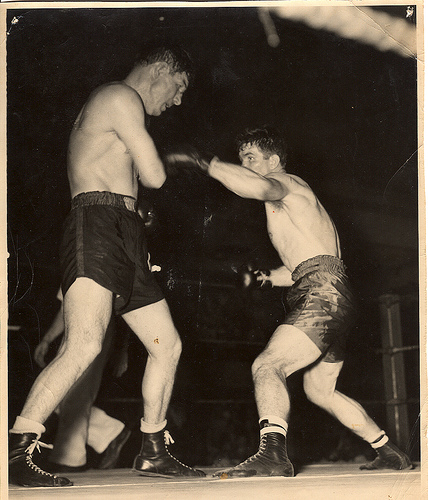Early years
Boxing first appeared as a formal
Olympic event in the 23rd Olympiad (688
BC),
but fist-fighting contests must certainly have had their origin in
mankind's prehistory. The earliest visual evidence for boxing appears
in Sumerian relief carvings from the 3rd millennium
BC. A relief sculpture from
Egyptian Thebes (
c. 1350
BC)
shows both boxers and spectators. The few extant Middle Eastern and
Egyptian depictions are of bare-fisted contests with, at most, a simple
band supporting the wrist; the earliest evidence of the use of gloves or hand coverings in boxing is a carved vase from Minoan Crete (
c. 1500
BC) that shows helmeted boxers wearing a stiff plate strapped to the fist.
The earliest evidence of rules for the sport comes from
ancient Greece.
These ancient contests had no rounds; they continued until one man
either acknowledged defeat by holding up a finger or was unable to
continue. Clinching (holding an opponent at close quarters with one or
both arms) was strictly forbidden. Contests were held outdoors, which
added the challenge of intense heat and bright sunlight to the fight.
Contestants represented all social classes; in the early years of the
major athletic festivals, a preponderance of the boxers came from
wealthy and distinguished backgrounds.
The Greeks considered boxing the most injurious of their sports. A 1st-century-
BC
inscription praising a pugilist states, “A boxer's victory is gained in
blood.” In fact, Greek literature offers much evidence that the sport
caused disfigurement and, occasionally, even death. An amazingly bloody
bout is recounted by Homer in the
Iliad (
c. 675
BC):
“Sons of Atreus, and all you other strong-greaved Achaians,
we invite two men, the best among you, to contend for these prizes
with their hands up for the blows of boxing.


